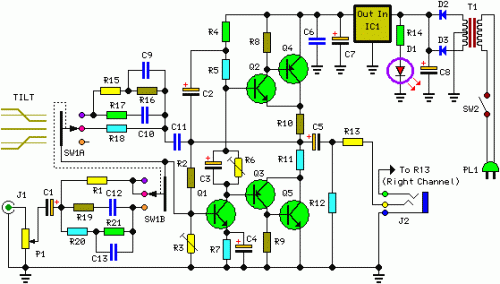Description
Parts
Notes:
Technical data:
Output power (1KHz sinewave):
Sensitivity:
This design is derived from the Portable Headphone Amplifier featuring
an NPN/PNP compound pair emitter follower output stage. An improved
output driving capability is gained by making this a push-pull Class-A
arrangement. Output power can reach 427mW RMS into a 32 Ohm load at a
fixed standing current of 100mA. The single voltage gain stage allows
the easy implementation of a shunt-feedback circuitry giving excellent
frequency stability.
Tilt control:
The mentioned shunt-feedback configuration also allows the easy addition of frequency dependent networks in order to obtain an useful, unobtrusive, switchable Tilt control (optional). When SW1 is set in the first position a gentle, shelving bass lift and treble cut is obtained. The central position of SW1 allows a flat frequency response, whereas the third position of this switch enables a shelving treble lift and bass cut.
Circuit Diagram:The mentioned shunt-feedback configuration also allows the easy addition of frequency dependent networks in order to obtain an useful, unobtrusive, switchable Tilt control (optional). When SW1 is set in the first position a gentle, shelving bass lift and treble cut is obtained. The central position of SW1 allows a flat frequency response, whereas the third position of this switch enables a shelving treble lift and bass cut.
Parts
- P1 = 22K Dual gang Log Potentiometer (ready for Stereo)
- R1 = 15K 1/4W Resistor
- R2 = 220K 1/4W Resistor
- R3 = 100K 1/2W Trimmer Cermet
- R4 = 33K 1/4W Resistor
- R5 = 68K 1/4W Resistor
- R6 = 50K 1/2W Trimmer Cermet
- R7 = 10K 1/4W Resistor
- R8 = 47K 1/4W Resistors
- R9 = 47K 1/4W Resistors
- R10 = 2R2 1/4W Resistors
- R11 = 2R2 1/4W Resistors
- R12 = 4K7 1/4W Resistor
- R13 = 4R7 1/2W Resistor
- R14 = 1K2 1/4W Resistor
- R15 = 330K 1/4W Resistors (Optional)
- R16 = 680K 1/4W Resistor (Optional)
- R17 = 220K 1/4W Resistors (Optional)
- R18 = 330K 1/4W Resistors (Optional)
- R19 = 220K 1/4W Resistors (Optional)
- R20 = 22K 1/4W Resistors (Optional)
- R21 = 22K 1/4W Resistors (Optional)
- C1 = 10µF 25V Electrolytic Capacitors
- C2 = 10µF 25V Electrolytic Capacitors
- C3 = 10µF 25V Electrolytic Capacitors
- C4 = 10µF 25V Electrolytic Capacitors
- C5 = 220µF 25V Electrolytic Capacitors
- C6 = 100nF 63V Polyester Capacitors
- C7 = 220µF 25V Electrolytic Capacitors
- C8 = 2200µF 25V Electrolytic Capacitor
- C9 = 1nF 63V Polyester Capacitors (Optional)
- C10 = 470pF 63V Polystyrene or Ceramic Capacitor (Optional)
- C13 = 15nF 63V Polyester Capacitor (Optional)
- C11 = 1nF 63V Polyester Capacitors (Optional)
- C12 = 1nF 63V Polyester Capacitors (Optional)
- D1 = 5mm. or 3mm. LED
- D2 = 1N4002 100V 1A Diodes
- D3 = 1N4002 100V 1A Diodes
- Q1 = BC550C 45V 100mA Low noise High gain NPN Transistors
- Q2 = BC550C 45V 100mA Low noise High gain NPN Transistors
- Q3 = BC560C 45V 100mA Low noise High gain PNP Transistor
- Q4 = BD136 45V 1.5A PNP Transistor
- Q5 = BD135 45V 1.5A NPN Transistor
- IC1 = 7815 15V 1A Positive voltage regulator IC
- T1 = 220V Primary, 15+15V Secondary-5VA Mains transformer
- SW1 = 4 poles 3 ways rotary Switch (ready for Stereo)
- SW2 = SPST slide or toggle Switch
- J1 = RCA audio input socket
- J2 = 6mm. or 3mm. Stereo Jack socket
- PL1 = Male Mains plug
- Q4, Q5 and IC1 must be fitted with a small U-shaped heatsink.
- For a Stereo version of this circuit, all parts must be doubled except P1, IC1, R14, D1, D2, D3, C8, T1, SW1, SW2, J2 and PL1.
- If the Tilt Control is not needed, omit SW1, all resistors from R15 onwards and all capacitors from C9 onwards. Connect the rightmost terminal of R1 to the Base of Q1.
- Before setting quiescent current rotate the volume control P1 to the minimum, Trimmer R6 to zero resistance and Trimmer R3 to about the middle of its travel.
- Connect a suitable headphone set or, better, a 33 Ohm 1/2W resistor to the amplifier output.
- Connect a Multimeter, set to measure about 10Vdc fsd, across the positive end of C5 and the negative ground.
- Switch on the supply and rotate R3 in order to read about 7.7-7.8V on the Multimeter display.
- Switch off the supply, disconnect the Multimeter and reconnect it, set to measure at least 200mA fsd, in series to the positive supply of the amplifier.
- Switch on the supply and rotate R6 slowly until a reading of about 100mA is displayed.
- Check again the voltage at the positive end of C5 and readjust R3 if necessary.
- Wait about 15 minutes, watch if the current is varying and readjust if necessary.
- Those lucky enough to reach an oscilloscope and a 1KHz sine wave generator, can drive the amplifier to the maximum output power and adjust R3 in order to obtain a symmetrical clipping of the sine wave displayed.
Output power (1KHz sinewave):
- 32 Ohm: 427mW RMS
- 64 Ohm: 262mW RMS
- 100 Ohm: 176mW RMS
- 300 Ohm: 64mW RMS
- 600 Ohm: 35mW RMS
- 2000 Ohm: 10mW RMS
- 140mV input for 1V RMS output into 32 Ohm load (31mW)
- 500mV input for 3.5V RMS output into 32 Ohm load (380mW)
- Total harmonic distortion into 32 Ohm load @ 1KHz:
- 1V RMS 0.005% 3V RMS 0.015% 3.65V RMS (onset of clipping) 0.018%
- Total harmonic distortion into 32 Ohm load @ 10KHz:
- 1V RMS 0.02% 3V RMS 0.055% 3.65V RMS (onset of clipping) 0.1%
- Unconditionally stable on capacitive loads






+ comments + 1 comments
This circuit comes from https://www.redcircuits.com/ in Italy, you can reach him at fladell@tin.it
Post a Comment